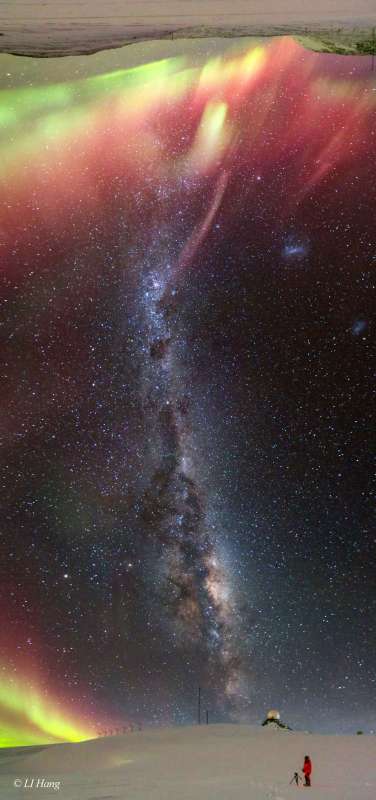
|
Credit & Copyright: LI Hang
Explanation:
It has been one of the better skies of this long night.
In
parts of
Antarctica, not only is it winter, but the Sun can spend weeks below the horizon.
At China's
Zhongshan Station,
people sometimes venture out into the cold to photograph a spectacular night sky.
The featured image from one such outing was taken in mid-July,
just before the end of this
polar night.
Pointing up, the
wide angle lens
captured not only the ground at the bottom, but at the top as well.
In the foreground is a colleague also taking pictures.
In the distance, a spherical satellite receiver and several
windmills
are visible.
Numerous stars dot the night sky, including
Sirius and
Canopus.
Far in the background, stretching overhead from horizon to horizon, is the
central band of our
Milky Way Galaxy.
Even further in the distance, visible as extended smudges near the top, are the
Large and
Small Magellanic
Clouds, satellite galaxies near our huge
Milky Way Galaxy.
Follow APOD on:
Facebook,
Google Plus,
or
Twitter
|
January February March April May June July August September October November December |
| ||||||||||||||||||||||||||||||||||||||||||||||||
NASA Web Site Statements, Warnings, and Disclaimers
NASA Official: Jay Norris. Specific rights apply.
A service of: LHEA at NASA / GSFC
& Michigan Tech. U.
Based on Astronomy Picture
Of the Day
Publications with keywords: aurora - Antarctica
Publications with words: aurora - Antarctica
See also:
- APOD: 2025 January 7 Á A New Years Aurora and SAR Arc
- APOD: 2024 December 8 Á Aurora around Saturns North Pole
- APOD: 2024 October 16 Á Colorful Aurora over New Zealand
- APOD: 2024 October 13 Á Aurora Timelapse Over Italian Alps
- Northern Lights, West Virginia
- Aurora Australis and the International Space Station
- APOD: 2024 June 26 Á Timelapse: Aurora, SAR, and the Milky Way
